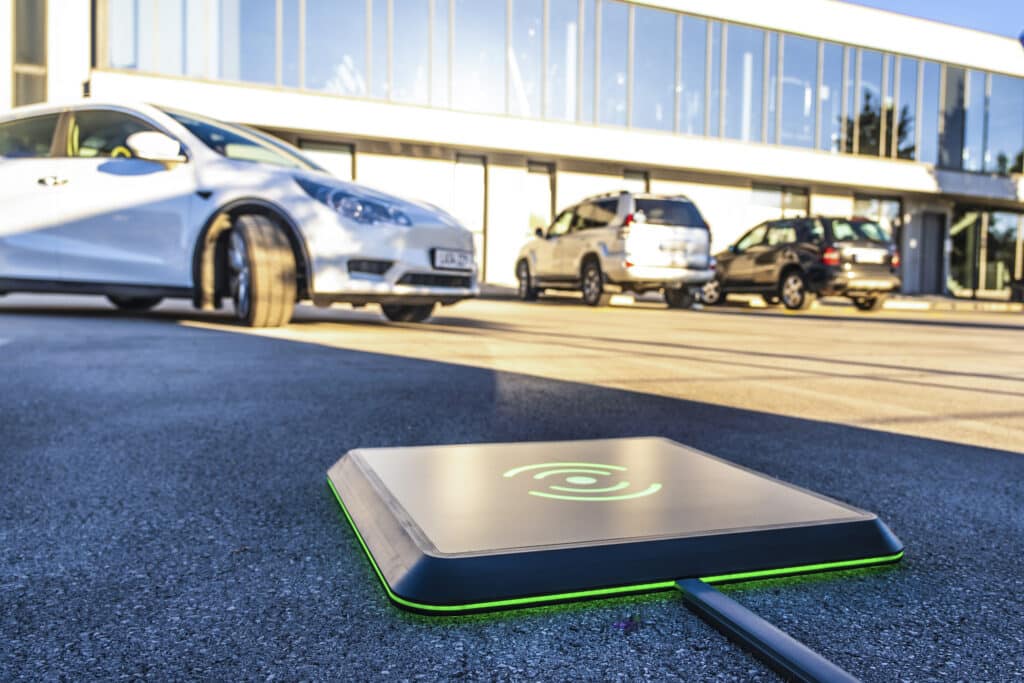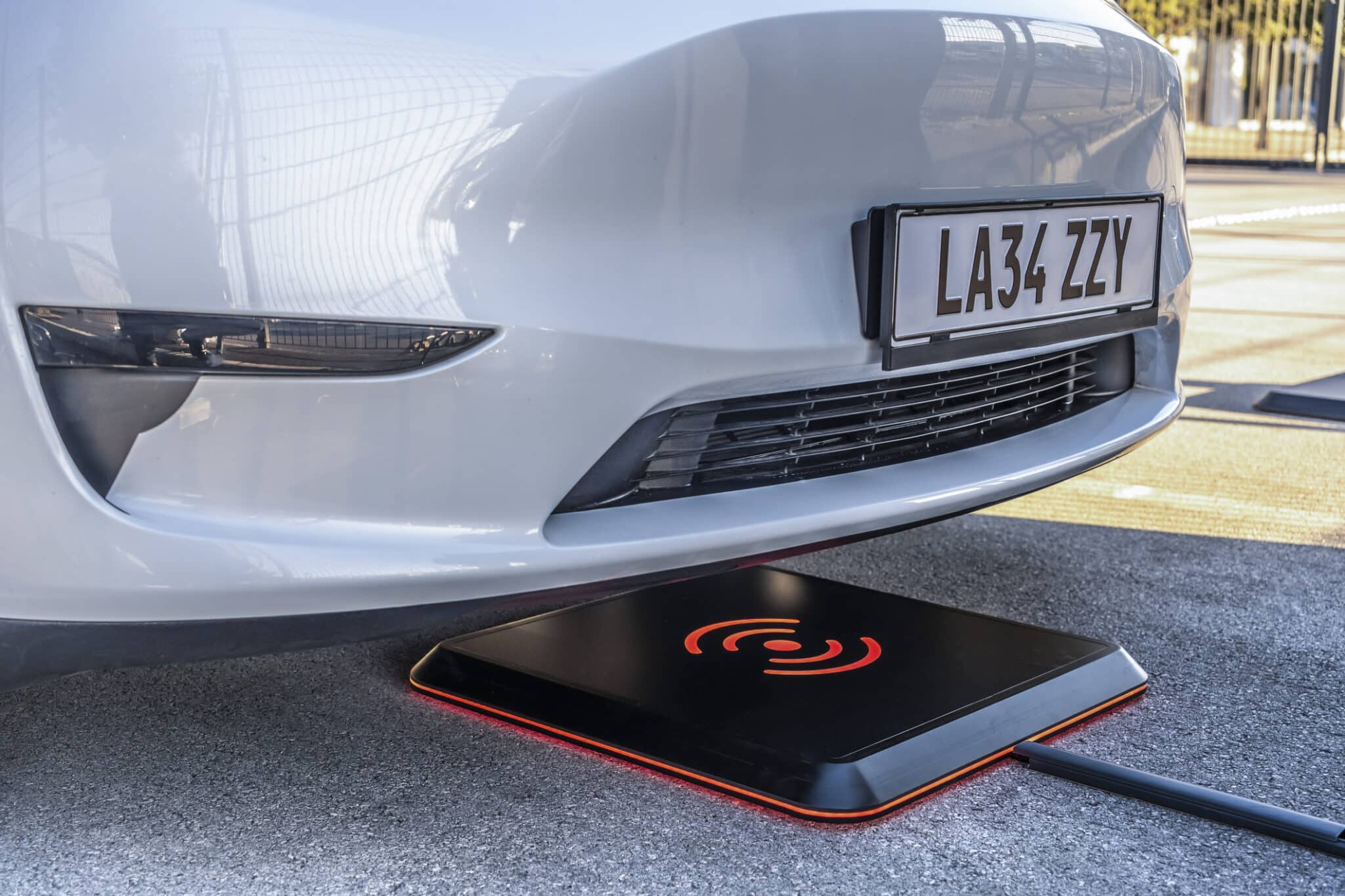Parking your electric vehicle (EV) and letting it charge without plugging in a cable—just pure convenience! Wireless charging uses electromagnetic fields to transfer power from a charging pad to your car’s battery. This technology offers:
- Ease of Use: Just park over the charging pad, and charging starts automatically.
- Reduced Wear and Tear: No cablesto handle, reducing maintenance.
- Safety: Eliminates risks associated with exposed wires.
- Future-Proofing: Prepares your home for evolving EV technology.

Are you tired of fumbling with charging cables every time you need to power up your electric vehicles? Imagine simply parking your car and letting it charge itself – no plugs, no hassle.
Wireless charging is the next big thing in the world of electric vehicles, and it’s changing how we think about powering up our rides.
Whether you’re a tech enthusiast or just someone looking for more convenience, this guide will walk you through everything you need to know about wireless charging for EVs. Ready to dive in?
What is Wireless Charging?
Wireless charging is exactly what it sounds like – a way to power up your EV without plugging in a cable. Instead, you park your car over a charging pad, and voila! The battery starts recharging. This technology is not only futuristic but also incredibly easy to use, making it a hot topic for EV owners everywhere.
Wireless charging for EVs works through electromagnetic fields, similar to how your phone might charge wirelessly. It’s a hands-free way to keep your car juiced up, eliminating the hassle of connecting and disconnecting heavy cables.
In places like Charleston, where the weather can sometimes be unpredictable, this means no more wrestling with cords in the rain or snow.
But it’s not just about convenience. Wireless charging is also a great way to future-proof your setup, making sure you’re ready as technology evolves.
As more and more electric vehicles hit the market, this tech could soon become the standard. So, understanding how it works now can give you a head start on everyone else.
Benefits of Wireless Charging for EVs
Convenience and Ease of Use
One of the biggest advantages of wireless charging is how simple it is to use. No more messing around with cables or finding the right plug; just park your car, and charging begins automatically.
This is especially handy when you’re in a hurry or have your hands full with groceries. It’s as easy as parking your car in your driveway or garage and letting the technology do the rest.
Reduced Wear and Tear on Charging Cables
Charging cables can suffer from wear and tear over time, especially if they’re used frequently or exposed to harsh weather conditions.
With wireless charging, there are no cables to worry about, which means less maintenance and fewer replacements. This can save you money in the long run and keep your charging setup looking neat and tidy.
Enhanced Safety Features
Wireless charging systems are designed with safety in mind. There’s no risk of electric shocks from exposed wires, and the system only activates when it detects a compatible vehicle, reducing the risk of accidents.
This added layer of safety makes wireless charging an attractive option for families, particularly those with young children or pets.
Future-Proofing Your EV Charging Setup
As technology advances, more and more electric vehicles will likely come equipped with wireless charging capabilities.
By investing in wireless charging now, you’re setting yourself up for the future, ensuring your home is ready for the latest EV models. Plus, it could even add value to your property if you ever decide to sell.
Integrating with Smart Home Systems
Wireless charging systems can be easily integrated with smart home technology, allowing you to monitor and control your EV’s charging process from your smartphone or other devices.
This means you can schedule charging sessions, track energy usage, and even receive alerts if something goes wrong – all from the comfort of your couch.
How Wireless Charging Technology Works
The Science Behind Wireless Power Transfer
At the heart of wireless charging is a technology called wireless power transfer (WPT). This process involves transferring energy between two objects using an electromagnetic field.
In the case of EVs, this energy transfer happens between a charging pad on the ground and a receiver on the bottom of your vehicle.
The charging pad generates an electromagnetic field, and when your car is parked over it, the receiver converts that field back into electrical energy to charge the battery. It’s a bit like magic, but it’s really just physics at work!
Key Components of a Wireless Charging System
A typical wireless charging system for EVs includes three main components:
- Charging Pad: Usually installed on the ground, in your garage, or driveway, this pad generates the electromagnetic field needed to transfer energy.
- Vehicle Receiver: Attached to the underside of your EV, this device captures the energy from the charging pad and converts it into electricity to charge the battery.
- Control Unit: Manages the power flow between the charging pad and vehicle receiver, ensuring the system operates safely and efficiently.
Together, these components make wireless charging a seamless experience.
The Process of Charging an EV Wirelessly
Charging your EV wirelessly is incredibly straightforward. Once the system is installed, all you need to do is park your car over the charging pad. The control unit detects the vehicle and starts the charging process automatically.
There’s no need to plug in any cables or even press a button – it’s all handled by the system. Charging continues until your vehicle’s battery is full, at which point the system will shut off to prevent overcharging. It’s as simple as that!
Challenges and Considerations with Wireless Charging
Efficiency Compared to Wired Charging
While wireless charging is convenient, it’s important to note that it can be slightly less efficient than traditional wired charging. Some energy is lost in the transfer process, which means it may take a bit longer to charge your vehicle.
However, the difference in efficiency is typically small, and for most users, the added convenience outweighs this minor drawback.
Cost of Installation and Maintenance
Setting up a wireless charging system can be more expensive than a wired setup, mainly due to the cost of the charging pad and the necessary modifications to your vehicle.
Additionally, while maintenance is minimal, any repairs that do become necessary might also be costlier due to the complexity of the system. It’s something to consider if you’re on a tight budget.
Compatibility with Different EV Models
Not all electric vehicles are currently compatible with wireless charging, so it’s crucial to check whether your model supports this technology before making any investments.
However, as more manufacturers adopt wireless charging capabilities, compatibility is expected to increase, making it a more accessible option for EV owners.
Environmental Impact and Energy Losses
The energy loss associated with wireless charging isn’t just about efficiency; it also has an environmental impact. The small amount of energy that’s lost during the transfer process could add up over time, leading to a slightly higher carbon footprint compared to wired charging.
For eco-conscious consumers, this is a consideration to keep in mind when deciding between the two options.
Types of Wireless Charging Systems
Static Wireless Charging
Static wireless charging is the most common type of wireless charging system available for electric vehicles today. With this system, your car must remain stationary over a charging pad to receive power.
This is perfect for home use, where you can easily park your vehicle in your garage or driveway and let it charge overnight. Static charging is reliable and convenient, making it a popular choice among EV owners who value ease of use and minimal setup.
Dynamic Wireless Charging
Imagine charging your car while driving down the road – that’s the idea behind dynamic wireless charging. This cutting-edge technology is still in its early stages, but the concept is incredibly exciting.
Special charging lanes embedded with wireless charging infrastructure could allow EVs to charge on the go, reducing the need for long stops at charging stations.
While it’s not widely available yet, dynamic wireless charging could revolutionize how we think about electric vehicle travel in the future.
Resonant Wireless Charging
Resonant wireless charging offers a bit more flexibility than static systems. It uses resonant inductive coupling, allowing the vehicle to be slightly misaligned with the charging pad without losing efficiency.
This means you don’t have to worry about parking perfectly over the pad to get a good charge. Resonant charging is particularly useful in public charging stations or areas where precise alignment might be challenging.
The Role of Professionals in Wireless Charging Installation
Why Professional Installation is Essential
Installing a wireless charging system for your electric vehicle isn’t a DIY project. Professional installation is essential to ensure that the system is set up correctly and safely.
Professionals are trained to handle the electrical work required, which includes not only installing the charging pad but also ensuring your home’s electrical system can support the new technology.
They’ll also make sure that everything meets local codes and regulations, giving you peace of mind that your setup is safe and reliable.
The Risks of DIY Electrical Work
Attempting to install a wireless charging system on your own can be risky. Here’s why it’s better to leave it to the professionals:
- Potential damage: Without the proper knowledge and tools, you might end up damaging the equipment, your vehicle, or even your home’s electrical system.
- Electrical hazards: Improper installation could lead to serious hazards, such as electric shocks or fires.
- Costly mistakes: The expense of fixing these mistakes can far outweigh the cost of hiring a professional in the first place.
When it comes to your safety and the functionality of your EV, it’s best to leave the job to the experts.
Safety Considerations for Wireless Charging
Preventing Electromagnetic Interference
One concern with wireless charging is the potential for electromagnetic interference (EMI). This occurs when the electromagnetic fields used in wireless charging interfere with other electronic devices.
However, modern wireless charging systems for electric vehicles are designed with safeguards to minimize this risk.
Manufacturers carefully design these systems to operate within specific frequencies that are less likely to interfere with other electronics, ensuring that your wireless charging setup won’t disrupt your home’s other devices, including those in your electric vehicles.
Ensuring Safe Installation of Charging Pads
Proper installation of the charging pad is crucial to the safety and efficiency of your wireless charging system for electric vehicles. The pad needs to be installed on a level surface and aligned correctly with your electric vehicle’s receiver to function optimally.
A professional installer will ensure that the pad is securely mounted, preventing any movement that could lead to inefficient charging or damage to your electric vehicles.
The Importance of Regular System Inspections
Just like any other piece of technology, a wireless charging system for electric vehicles requires regular inspections to ensure it continues to operate safely and efficiently.
Over time, wear and tear can affect the components, potentially leading to issues if not addressed promptly. Scheduling regular maintenance checks with a professional can help catch and resolve minor problems before they become major safety concerns.
Safety Features Built into Modern Wireless Charging Systems
Modern wireless charging systems for electric vehicles come equipped with several safety features to protect both the vehicle and the user.
These include automatic shutoff mechanisms that prevent overcharging, temperature sensors that monitor and manage heat levels, and systems that detect foreign objects on the charging pad, which could otherwise cause malfunctions.
Preparing Your Home for Wireless Charging
Assessing Your Home’s Electrical Infrastructure
Before installing a wireless charging system for your electric vehicle, it’s essential to assess your home’s electrical infrastructure.
Not all homes are ready to support the additional load that a wireless charging system for electric vehicles can place on the electrical grid.
A professional electrician can evaluate your current setup, including your circuit breaker and wiring, to determine if any upgrades are necessary.
Upgrading Your Electrical Panel if Necessary
If your home’s electrical system isn’t up to the task, you may need to upgrade your electrical panel. This could involve installing a higher-capacity breaker or even rewiring certain parts of your home.
While this might seem like a significant investment, it’s crucial for safely operating your wireless charging system for electric vehicles.
Upgrading your panel ensures that your home can efficiently and safely handle the increased power demand, reducing the risk of electrical issues down the line and ensuring a reliable charging experience for your electric vehicles.
Choosing the Right Location for the Charging Pad
Selecting the optimal location for your charging pad is key to maximizing the efficiency and convenience of your wireless charging system for electric vehicles.
Ideally, the pad should be placed in a spot where you regularly park your electric vehicles, such as your garage or driveway.
It’s important to consider factors like proximity to your home’s electrical supply, ease of access, and whether the area is sheltered from the elements.
Understanding the Installation Process and Timeline
Knowing what to expect during the installation process can help you plan accordingly. The installation typically involves several steps, including evaluating your electrical system, preparing the installation site, and mounting the charging pad.
Depending on your home’s setup, the process can take anywhere from a few hours to a couple of days.
Understanding this timeline allows you to schedule the installation at a convenient time and ensures that you’re fully prepared for any temporary disruptions, making sure your home is ready to support the seamless charging of your electric vehicles.

Electric Vehicles FAQs
Can all electric vehicles use wireless charging?
Not all electric vehicles are compatible with wireless charging. It’s important to check if your specific model supports this technology. Compatibility is expected to increase as more manufacturers adopt wireless charging capabilities.
How long does it take to charge an electric vehicle wirelessly?
Charging times for electric vehicles with wireless charging can vary. Generally, it’s comparable to wired charging, though slight energy losses may extend the time slightly. The difference in charging time is usually minimal.
Is wireless charging safe for my electric vehicle’s battery?
Yes, modern wireless charging systems are safe for electric vehicles batteries. They include features that prevent overcharging and monitor battery health. This ensures your battery remains in good condition.
How much does it cost to install a wireless charging system for an electric vehicle?
The cost varies based on your home’s electrical setup and the system you choose. Expect to invest more than you would for a traditional wired charger. The long-term benefits often outweigh the initial cost.
Can I install a wireless charging system for electric vehicles outdoors?
Yes, many wireless charging systems are designed to be weather-resistant. They can be installed outdoors in a driveway or other suitable location. This makes them a versatile option for electric vehicle owners.
Do Wireless Charging Systems Affect the Range of Electric Vehicles?
No, wireless charging systems do not directly affect the range of electric vehicles. The range of an electric vehicle is determined by the capacity of its battery and the efficiency of the vehicle itself. Wireless charging provides an alternative way to charge without plugging in, but the amount of charge and overall range remain the same as with traditional wired charging methods.






